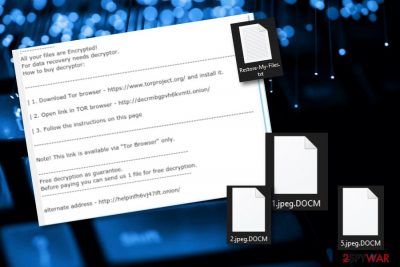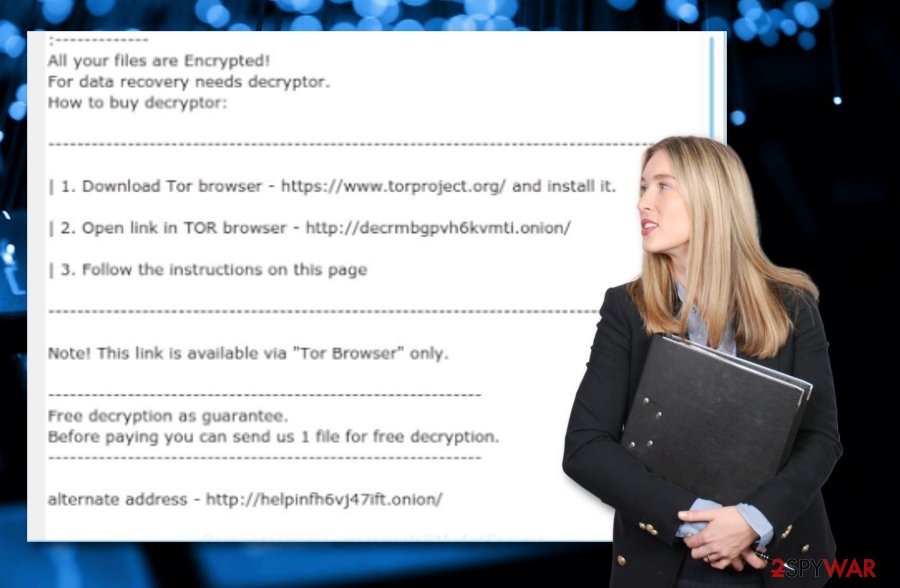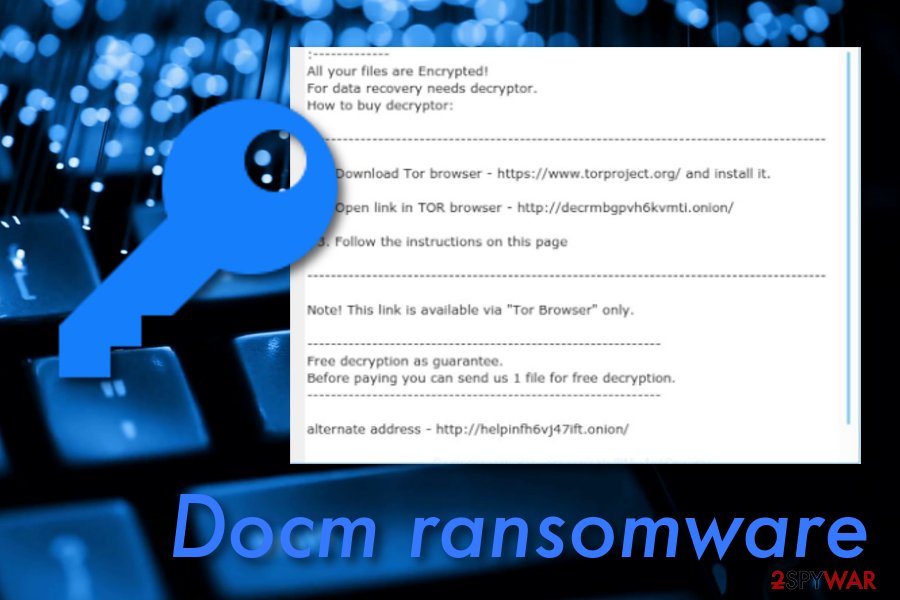Docm ransomware (Improved Instructions) - Removal Guide
Docm virus Removal Guide
What is Docm ransomware?
Docm ransomware – a sibling of the malicious Globe Imposter family

Docm ransomware appears to be a dangerous malware form related to the Globe Imposter family. There are some user reports released about this cyber threat emerging on their Windows computers and leaving files with the .DOCM appendix added. Furthermore, infected people claim that they have received the Restore-My-Files.txt message with urges to buy the original decrypter for .DOCM files from the cybercriminals directly.[1] What is even more interested, some people have discovered that .DOCM files virus appeared after downloading a particular update for Microsoft Word documents by pressing the “Update now” button.[2] This seems to have left the victim with encrypted files and sadly, no official decryptor has yet been released.
| Name | Docm |
|---|---|
| Type | Ransomware |
| Family | Globe Imposter |
| Extension | .DOCM |
| Ransom note | Restore-My-Files.txt |
| Price | No particular details are given |
| Spreading source | Infectious files and documents, fake updates, spam messages |
| Detection tool | FortectIntego can help you to detect all malicious components |
Docm virus seems to have been troubling numerous Windows users lately. By entering the computer through fake updates, malicious attachments, or spam messages this malware seems to have reached great success throughout its operating history. What makes it even more effective is that there is no original decryption key released for it yet.
As Docm ransomware text message claims, victims can by decryption software for their locked files from the cybercriminals directly but they need to download the Tor browser[3] and follow instructions for payment transferring. However, as you can see from the ransom note, no particular details about the demanded price are provided:
All my files are encrypted as .DOCM . A .txt file in every folder as below:
All your files are Encrypted!
For data recovery needs decryptor.
How to buy decryptor:—————————————————————————————-
| 1. Download Tor browser – https://www.torproject.org/ and install it.
| 2. Open link in TOR browser – http://decrmbgpvh6kvmti.onion/
| 3. Follow the instructions on this page—————————————————————————————-
Note! This link is available via “Tor Browser” only.
————————————————————
Free decryption as guarantee.
Before paying you can send us 1 file for free decryption.
————————————————————alternate address – http://helpinfh6vj47ift.onion/
Docm ransomware also appears to offer to send the criminals a file for free decryption just to show evidence of the existing decryption key. However, we suggest not believing in any promises that are provided by these people as all of them often appear to be fake and just one big scam for money swindling purposes.
Nevertheless, Docm ransomware and similar cyber threats might relate to deletion of Shadow Volume Copies, injection of other malware forms, planting malicious executables and other files. Additionally, these infections can run malicious processes in the background and successfully avoid being detected by antivirus programs.

Avoid all possible damage that might be caused by this file-encrypting malware and use a tool such as FortectIntego to remove Docm ransomware from the Windows computer system permanently. Additionally, this software is capable of detecting all other infectious components that might have been planted by the ransomware virus during the attack.
Docm ransomware removal process is a reputable activity to carry out, so you should no try to eliminate the malware on your own. Talking about data recovery purposes, some possibly-successful software has been added at the end of this article. Try out some of these methods as it is definitely better than paying a big amount of many to hackers.

Ransomware and phishing emails are the best combination
Experiencing file encryption and ransom demands is an accurate sign of a ransomware infection. Have you ever wondering from where do these cyber threats appear? However, mostly crooks use various sneaky techniques to infiltrate malware straight into the victim's computer system which frequently appears to be successful.
Note that ransomware viruses and similar malware have the ability to infiltrate the machine through spam messages. If you ever receive questionable-looking emails that include grammar mistakes, incoherent text, and dubious files attached, this should be a warning to you that such a message should be instantly deleted rather than opened.
Furthermore, there might be other ransomware distribution sources that can carry a malicious payload. For example, many cybercriminals misuse open third-party sources that do not fit security requirements for malware injection into secondary downloading links, pop-up notifications, and other similar directories.
For automatical protection, we recommend choosing a reputable anti-malware tool that has the best reviews possible. You will not regret purchasing such software if you choose ane expert-tested program and keep it regularly updated. Additionally, you can use the scan feature for checking all received files, documents, and programs.
The elimination process of .DOCM files virus
Removing dangerous cyber threats such as DOCM virus requires advanced skills in the threat removal field and if you lack some, the manual elimination technique might not be a good possibility for you. Also, this type of malware might have brought numerous malicious files and components to the targeted computer system which might too hard to detect by the human eye.
We recommend all users to take care of DOCM ransomware removal with the help of reputable anti-malware software. First of all, a full system scan is necessary. This type of process can be completed by downloading and installing a tool such as FortectIntego, SpyHunter 5Combo Cleaner, or Malwarebytes. Performing a complete machine check-up will allow you to detect all possibly-malicious content.
After you remove DOCM ransomware from your Windows operating system and the threat is no longer posing any harm, you can continue with data restoring steps. Choose the right file recovery method and you might have the chance of bringing back some of your documents/files back to their previous states.
According to cybersecurity experts from Virusai.lt,[4] you should be concerned about your data safety in the future. To prevent similar attacks such as DOCM ransomware in the upcoming future, you should find a remote server or device to store your data. You can use portable drives such as USB Flash Drive and similar.
Getting rid of Docm virus. Follow these steps
Manual removal using Safe Mode
Boot your computer to Safe Mode with Networking to deactivate all malicious activities that are ongoing on the system:
Important! →
Manual removal guide might be too complicated for regular computer users. It requires advanced IT knowledge to be performed correctly (if vital system files are removed or damaged, it might result in full Windows compromise), and it also might take hours to complete. Therefore, we highly advise using the automatic method provided above instead.
Step 1. Access Safe Mode with Networking
Manual malware removal should be best performed in the Safe Mode environment.
Windows 7 / Vista / XP
- Click Start > Shutdown > Restart > OK.
- When your computer becomes active, start pressing F8 button (if that does not work, try F2, F12, Del, etc. – it all depends on your motherboard model) multiple times until you see the Advanced Boot Options window.
- Select Safe Mode with Networking from the list.

Windows 10 / Windows 8
- Right-click on Start button and select Settings.

- Scroll down to pick Update & Security.

- On the left side of the window, pick Recovery.
- Now scroll down to find Advanced Startup section.
- Click Restart now.

- Select Troubleshoot.

- Go to Advanced options.

- Select Startup Settings.

- Press Restart.
- Now press 5 or click 5) Enable Safe Mode with Networking.

Step 2. Shut down suspicious processes
Windows Task Manager is a useful tool that shows all the processes running in the background. If malware is running a process, you need to shut it down:
- Press Ctrl + Shift + Esc on your keyboard to open Windows Task Manager.
- Click on More details.

- Scroll down to Background processes section, and look for anything suspicious.
- Right-click and select Open file location.

- Go back to the process, right-click and pick End Task.

- Delete the contents of the malicious folder.
Step 3. Check program Startup
- Press Ctrl + Shift + Esc on your keyboard to open Windows Task Manager.
- Go to Startup tab.
- Right-click on the suspicious program and pick Disable.

Step 4. Delete virus files
Malware-related files can be found in various places within your computer. Here are instructions that could help you find them:
- Type in Disk Cleanup in Windows search and press Enter.

- Select the drive you want to clean (C: is your main drive by default and is likely to be the one that has malicious files in).
- Scroll through the Files to delete list and select the following:
Temporary Internet Files
Downloads
Recycle Bin
Temporary files - Pick Clean up system files.

- You can also look for other malicious files hidden in the following folders (type these entries in Windows Search and press Enter):
%AppData%
%LocalAppData%
%ProgramData%
%WinDir%
After you are finished, reboot the PC in normal mode.
Remove Docm using System Restore
By activating System Restore on Windows, you might be capable of preventing hazardous activities from continuing:
-
Step 1: Reboot your computer to Safe Mode with Command Prompt
Windows 7 / Vista / XP- Click Start → Shutdown → Restart → OK.
- When your computer becomes active, start pressing F8 multiple times until you see the Advanced Boot Options window.
-
Select Command Prompt from the list

Windows 10 / Windows 8- Press the Power button at the Windows login screen. Now press and hold Shift, which is on your keyboard, and click Restart..
- Now select Troubleshoot → Advanced options → Startup Settings and finally press Restart.
-
Once your computer becomes active, select Enable Safe Mode with Command Prompt in Startup Settings window.

-
Step 2: Restore your system files and settings
-
Once the Command Prompt window shows up, enter cd restore and click Enter.

-
Now type rstrui.exe and press Enter again..

-
When a new window shows up, click Next and select your restore point that is prior the infiltration of Docm. After doing that, click Next.


-
Now click Yes to start system restore.

-
Once the Command Prompt window shows up, enter cd restore and click Enter.
Bonus: Recover your data
Guide which is presented above is supposed to help you remove Docm from your computer. To recover your encrypted files, we recommend using a detailed guide prepared by 2-spyware.com security experts..DOCM files signify about the DOCM ransomware infection. If you have spotted this type of appendix next to your documents, get rid of the malware immediately and continue with the following data recovery steps:
If your files are encrypted by Docm, you can use several methods to restore them:
Data Recovery Pro software might help you to recover some encrypted data files:
Use this third-party tool to recover some of your files that have been locked by the ransomware virus.
- Download Data Recovery Pro;
- Follow the steps of Data Recovery Setup and install the program on your computer;
- Launch it and scan your computer for files encrypted by Docm ransomware;
- Restore them.
Windows Previous Versions feature should allow you to restore some documents/files:
Try using this tool to restore some encrypted files. Follow all steps exactly as shown in the instructing guide:
- Find an encrypted file you need to restore and right-click on it;
- Select “Properties” and go to “Previous versions” tab;
- Here, check each of available copies of the file in “Folder versions”. You should select the version you want to recover and click “Restore”.
No official .DOCM files decrypter has been discovered yet. Experts should release it after the discovery soon.
Finally, you should always think about the protection of crypto-ransomwares. In order to protect your computer from Docm and other ransomwares, use a reputable anti-spyware, such as FortectIntego, SpyHunter 5Combo Cleaner or Malwarebytes
How to prevent from getting ransomware
Protect your privacy – employ a VPN
There are several ways how to make your online time more private – you can access an incognito tab. However, there is no secret that even in this mode, you are tracked for advertising purposes. There is a way to add an extra layer of protection and create a completely anonymous web browsing practice with the help of Private Internet Access VPN. This software reroutes traffic through different servers, thus leaving your IP address and geolocation in disguise. Besides, it is based on a strict no-log policy, meaning that no data will be recorded, leaked, and available for both first and third parties. The combination of a secure web browser and Private Internet Access VPN will let you browse the Internet without a feeling of being spied or targeted by criminals.
No backups? No problem. Use a data recovery tool
If you wonder how data loss can occur, you should not look any further for answers – human errors, malware attacks, hardware failures, power cuts, natural disasters, or even simple negligence. In some cases, lost files are extremely important, and many straight out panic when such an unfortunate course of events happen. Due to this, you should always ensure that you prepare proper data backups on a regular basis.
If you were caught by surprise and did not have any backups to restore your files from, not everything is lost. Data Recovery Pro is one of the leading file recovery solutions you can find on the market – it is likely to restore even lost emails or data located on an external device.
- ^ Tawhid72. .DOCM Ransomware. Emsisoft Support. Forums.
- ^ fekri_saleh1. .DOCM Ransomware. Microsoft Community. Help.
- ^ J.M. Porup. What is the Tor Browser? How it works and how it can help you protect your identity online. CSO Online. News Articles.
- ^ Virusai.lt. Virusai. Spyware and security news source.





















